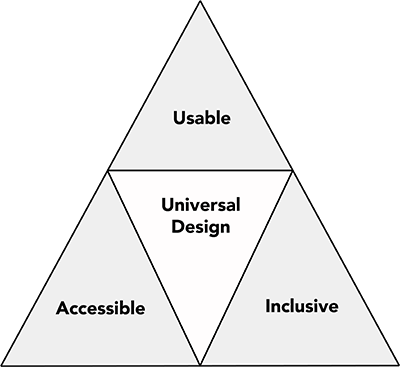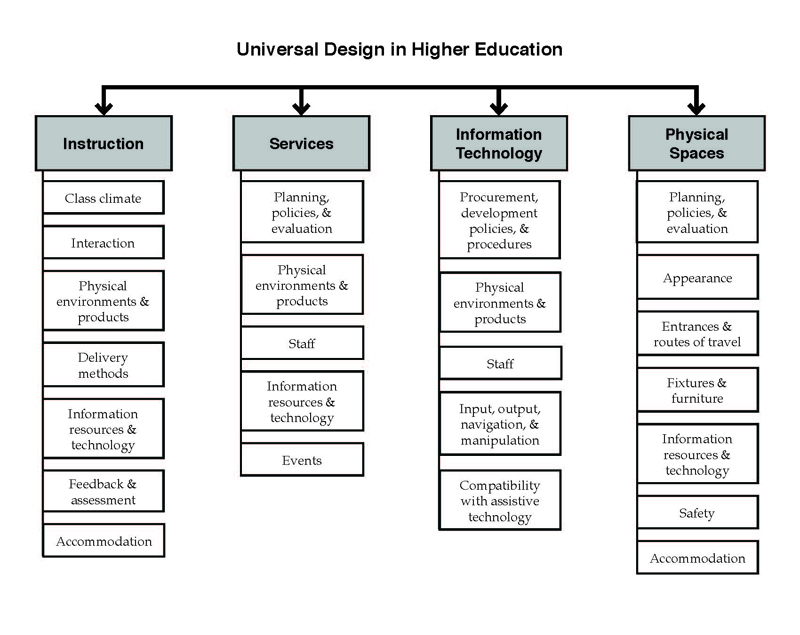Self-Examination: How Inclusive Is Your Campus?
College students are learning to take responsibility for their own lives. They’re making choices that will determine their success in life and careers. For those of us fortunate enough to be part of their education, there are responsibilities as well. We need to be prepared to work with students with very different backgrounds, experiences, first languages, abilities, and disabilities.
Typically, campuses provide accommodations for students with disabilities through a disability services office where students go to get special assistance. This model tries to fit individuals with disabilities into a system that may not be well‑designed for them. While some accommodations may always be necessary, others are needed simply because a course or resource was created in an inaccessible format.
A truly inclusive campus takes a more holistic approach. As reported by Beatrice Awoniyi, director and assistant dean for the Student Disability Resource Center at Florida State University, “We all have responsibilities for providing access and a welcoming environment for anyone on our campus. It is not an office responsibility; it is not just the disability services office or the disability services provider or the director or the coordinator that is responsible to making sure that access is provided for students with disabilities, or that their needs are being met. It is a university-wide responsibility.”
It takes an entire campus, from administration to architecture to academics, to create a welcoming and inclusive environment. Accessibility issues should be considered at all levels. Explained this way by John Pedraza, specialist at the Resource Center for Persons with Disabilities at Michigan State University, “It’s important that you have a president and a provost and deans that are supportive of accommodating persons with disabilities. And fortunately, I work at an institution that is like that.”
A proactive approach to designing environments and programs that are accessible to, usable by, and inclusive of everyone is called universal design (UD).
Student Services and Physical Spaces
From the very first contact, potential students with and without disabilities need access to the massive amount of information a college or university makes available online. Having a campus web accessibility policy is critical to ensuring consistent, well-organized, and universally accessible electronic resources. Alice Anderson, a technology access program coordinator at the University of Wisconsin—Madison, notes, “Having a campus policy will do many things. It can give you a sense of how to focus your training. You can bring different groups together to discuss the issues and the solutions. A policy can also set a measuring stick for where you are and where you want to be. A policy is especially beneficial when you’re looking at how accessible you want your e-resources to be.”
Once on campus, students with disabilities need physical access to classrooms, libraries, dining areas—basically, everywhere a student might go. Plans for access should be included in building and landscape architecture. At North Georgia College and State University, as reported by Rodney Pennamon, “[We have] an ADA committee, an Americans with Disabilities Act committee, that looks at access issues around the campus. We recently have added students to that group of individuals, and so [feedback on access barriers] could come from a student, or oftentimes will come from a faculty member who may have some suggestions or some input…then my office will look at those…access issues.”
When addressing physical access, consider including ramps and doors with automatic openers, adjustable countertops or countertops at various heights in student service areas, materials in accessible formats, and dorm rooms with accessible bathrooms.
It is also important to consider accessibility issues when planning events such as career fairs, two‑year and four-year college transfer events, and campus tours. Hold them in accessible locations and announce the availability of accommodations in brochures and on websites.
Campuses should ensure that facilities, police, public safety, and all other relevant groups work together to ensure the accessibility of all student services, including admissions, registration, tutoring centers, career services, housing and food services, computer labs, and student organizations.
For guidelines on making student services accessible to all students, consult the video and publication Equal Access: Universal Design of Student Services. Publications tailored to specific services can be found on our Applications of Universal Design page.
Instruction
Instruction is the core of any college or university. By using UD and universal design for learning (UDL), instructors can create accessible spaces and course content, faculty can minimize the need for additional accommodations. As suggested by Rodney Pennemon, “When you’re designing your class and putting it together, you really need to think globally in terms of who’s going to be [your] audience, who do [you] need to reach? [There may be] younger students, non-traditional students, students from different backgrounds and different cultures…and so if you go in with the approach that you’re going to try to reach as many people as possible, it’s similar to giving a lecture: you’re going to have an audience of people that come from a lot of different backgrounds, and so you want to be able to appeal to as many different levels as possible.”
Instructors are encouraged to use a variety of methods for teaching content and offer alternative ways for participants to participate in class activities. A statement on the course syllabus encouraging students to meet with the instructor to discuss accommodations (in addition to standard wording for requesting specific accommodations through a centralized unit) helps create a supportive atmosphere. As summarized by Meryl Berstein, director at the Center for Academic Support at Johnson and Wales University, “Universal design is really making the classroom accessible for all students, not just for students with disabilities, and it really comes down to just good teaching. By teaching students through all the modalities—by hearing, by seeing, by touching—the information is accessible to all students in different ways.”
At the campus center for faculty development, UD and UDL could be integrated into all offerings. For more information on universal design of instruction (which combines UD and UDL principles), consult the video and publication entitled Equal Access: Universal Design of Instruction.
Campus Accessibility Indicators
The goal of systemic change for inclusion of people with disabilities on campus is to ensure that all people experience the campus fully and equally through the same venues. This can be done through ongoing development of an inclusive campus that embraces and celebrates diversity. The following indicators are starting points for conversation about how to create an inclusive campus. Suggestions for improving the list should be sent to doit@uw.edu.
University conversations:
- Institution-level mission, vision, and values statements are inclusive of all people, including those with disabilities.
- Disability is included in campus discussions of and training on diversity and special populations.
Administrative empowerment:
- Policies, procedures, and practices are regularly reviewed for barrier removal and inclusivity of people with a diverse range of characteristics, including disability.
- Administrators, staff, faculty, and student leaders are trained and empowered to take action around universal design and accommodation issues.
- People with disabilities are visible (even if their disabilities are not) on campus including in positions of power and authority (administrators, faculty, student leaders, etc.).
Infusion in all aspects of campus:
- Budgeting reflects the reality of the cost of employing UD and UDL principles and providing accommodations for current and prospective employees, students, and visitors with disabilities.
- Measures of student success (retention, course completion, graduation, etc.) are the same for all student populations, including students with disabilities, and institutional research includes this data.
- Campus marketing, publications, and public relations include images and content related to disabilities.
- Campus publications and websites, including web-based courses, meet established accessibility standards.
- Disability issues are regularly included as a component of the curriculum.
- All campus facilities are physically accessible.

UD is a work in progress. We at DO‑IT have collaborated with a national team of educators to create professional development materials and train faculty and administrators throughout the United States. We offer suggestions for the design of inclusive courses, technology, campus services, and physical spaces. Each UD application is accessible to, usable by, and inclusive of everyone, including those with disabilities.
Video to Complement this Publication
The content of this publication can be found in the video entitled Self-Examination: How Accessible Is Your Campus? This title, along with many other DO-IT videos, may be freely viewed at www.washington.edu/doit/videos/index.php. DVDs can be purchased from DO-IT at www.washington.edu/doit/do-it-videos-books-and-training-materials-order-form
Additional Resources
Select AccessCollege from www.uw.edu/doit to find links to comprehensive websites designed for faculty, administrators, and students:
- The Board Room
- The Center for Universal Design in Education
- The Employment Office
- The Faculty Room
- The Student Lounge
- The Student Services Conference Room
- The Veterans Center
Within these websites are guidelines and information that lead to more accessible courses and programs and that help students with disabilities prepare for success in college.
For more information about applications of universal design consult www.washington.edu/doit/resources/popular-resource-collections/applications-universal-design or The Center for Universal Design in Education at www.washington.edu/doit/programs/center-universal-design-education/overview. The book Universal Design in Higher Education: From Principles to Practice published by Harvard Education Press shares perspectives of UD leaders nationwide.

About DO-IT
DO-IT (Disabilities, Opportunities, Internetworking, and Technology) serves to increase the successful participation of individuals with disabilities in challenging academic programs such as those in science, engineering, mathematics, and technology. Primary funding for DO-IT is provided by the National Science Foundation, the State of Washington, and the U.S. Department of Education. DO-IT is a collaboration of UW Information Technology and the Colleges of Engineering and Education at the University of Washington.
Grants and gifts fund DO-IT publications, videos, and programs to support the academic and career success of people with disabilities. Contribute today by sending a check to DO-IT, Box 354842, University of Washington, Seattle, WA 98195-4842.
Your gift is tax deductible as specified in IRS regulations. Pursuant to RCW 19.09, the University of Washington is registered as a charitable organization with the Secretary of State, state of Washington. For more information call the Office of the Secretary of State, 1-800-322-4483.
To order free publications or newsletters use the DO-IT Publications Order Form; to order videos and training materials use the Videos, Books and Comprehensive Training Materials Order Form.
For further information, to be placed on the DO-IT mailing list, request materials in an alternate format, or to make comments or suggestions about DO-IT publications or web pages contact:
DO-IT
University of Washington
Box 354842
Seattle, WA 98195-4842
doit@uw.edu
www.uw.edu/doit
206-685-DOIT (3648) (voice/TTY)
888-972-DOIT (3648) (voice/TTY)
206-221-4171 (fax)
509-328-9331 (voice/TTY) Spokane
Founder and Director: Sheryl Burgstahler, Ph.D.
Acknowledgment
This publication was developed under a grant from the U.S. Department of Education, OPE #P333A050064. However, the contents do not necessarily represent the policy of the U.S. Department of Education, and you should not assume endorsement by the federal government.
© 2019, 2015, 2012, 2009, 2007 University of Washington. Permission is granted to copy these materials for educational, noncommercial purposes provided the source is acknowledged.